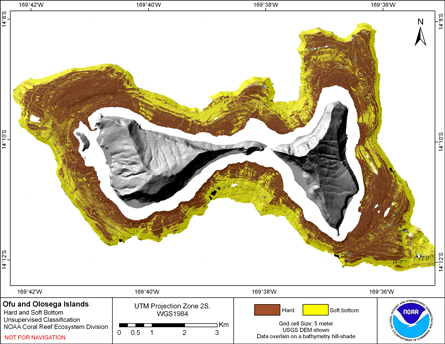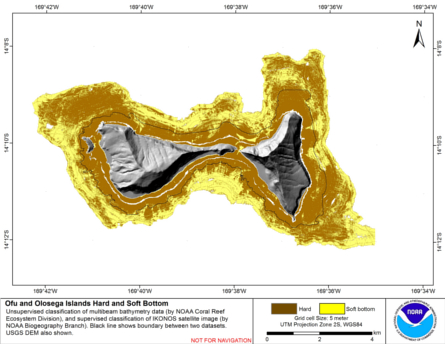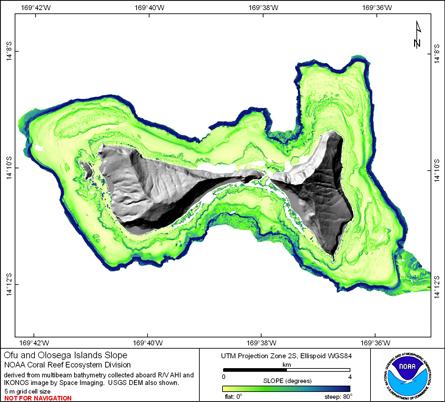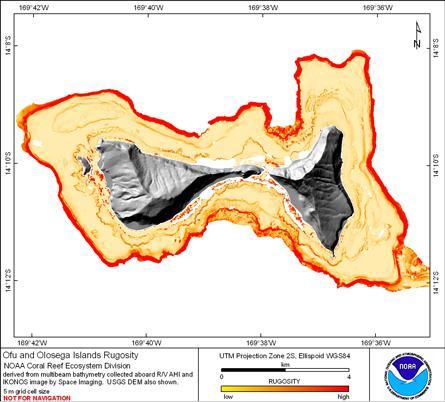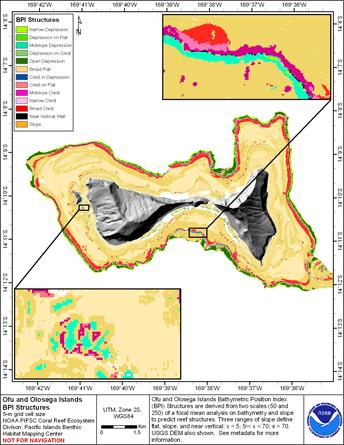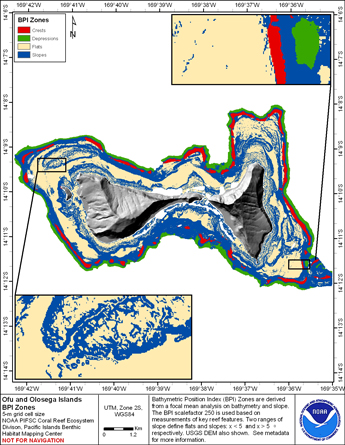[ Bathymetry | Backscatter | Optical Validation | Geomorphology ]
Download 5 meter grid:
Substrate, Slope, Rugosity, BPI Structures, BPI Zones
Click here for a Discussion of Geomorphological Layers
Zipped data files contain 1) Arc ASCII file, 2) layer (.lyr) file for symbology, 3) high-res JPG/PDF of image, and 4) explanatory metadata text file (identical to linked file listed below).
Substrate- Hard bottom vs. Soft bottom – 5 meter grid
Substrate :This product is derived from an unsupervised classification of multibeam bathymetric data derivatives and multibeam backscatter data. Cell values reflect whether the seafloor is hard or soft. Please see the metadata for additional information.
Download this image as a high-res JPG or PDF
Hard bottom vs. Soft bottom Substrate Classification Data Files
- GeoTIFFs: Metadata text • Zipped data
Top of the page
Substrate- Integrated Hard bottom vs. Soft bottom – 5 meter grid
Substrate: This is a product derived from combining the hard bottom vs. soft bottom map described above, with the shallow-water benthic habitat map for American Samoa, produced by NOAA Biogeography Branch (Center for Coastal Monitoring and Assessment, 2005). By combining these two maps, a product is created that covers the entire coral reef ecosystem from shoreline to its outer edge. The two datasets were combined by taking the ‘major structure’ attribute from the NOAA Biogeography Branch habitat map and converting this into a raster, where ‘coral reef and hardbottom’ was given the raster value for ‘hard’ and ‘unconsolidated sediment’ was given the raster value for ‘soft’ to correspond with the CRED hard vs. soft bottom raster. The two datasets were mosaicked in ArcGIS, using the NOAA Biogeography Branch shallow-water habitat map to fill in gaps in the CRED hard vs. soft substrate map. Please see the metadata for additional information.
References:
- Center for Coastal Monitoring and Assessment (2005). Shallow-water benthic habitats of American Samoa, Guam, and the Commonwealth of the Northern Mariana Islands. NOAA Technical Memorandum NOS NCCOS, Silver Spring, MD: National Oceanic and Atmospheric Administration, National Ocean Service, National Centers for Coastal Ocean Science, Center for Coastal Monitoring and Assessment.
Download this image as a high-res JPG or PDF
Integrated Hard bottom vs. Soft bottom Substrate Classification Data Files
- GeoTIFFs: Metadata text • Zipped data
Top of the page
Slope – 5 meter grid
Slope: Cell values reflect the maximum rate of change (in degrees) in elevation between neighboring cells. Slope was derived with the ArcGIS Spatial Analyst extension.
Download this image as a high-res JPG or PDF
Slope data files
- Arc ASCII: Metadata text • Zipped data
Top of the page
Rugosity – 5 meter grid
Rugosity:Cell values reflect the surface area / planimetric area ratio for the area contained within that cell’s boundaries. They provide indices of topographic roughness and convolutedness. (Jenness 2003)
Download this image as a high-res JPG or PDF
Rugosity data files
- Arc ASCII: Metadata text • Zipped data
Top of the page
BPI Structures – 5 meter grid
BPI Structures: Derived from two scales (50 & 250) of BPI; slope; and depth. Three ranges of slope defined flats, slopes and near vertical: x < 5; 5 < x < 70.
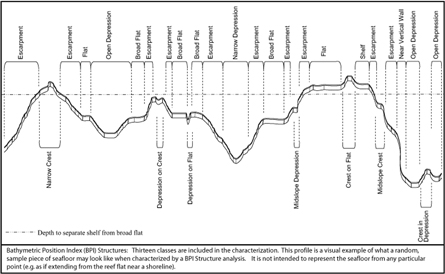 |
| A visual description of BPI Structure classes (Click image for larger view.) |
Download this image as a high-res JPG or PDF
BPI Structures data files
- Arc ASCII: Metadata text • Zipped data
Top of the page
BPI Zones – 5 meter grid
BPI Zones: Derived from a broad scale (250) BPI grid and slope. Two ranges of slope defined flats and slopes: x < 5 and 5 < x < 70.
Download this image as a high-res JPG or PDF
BPI Zones data files
- Arc ASCII: Metadata text • Zipped data
